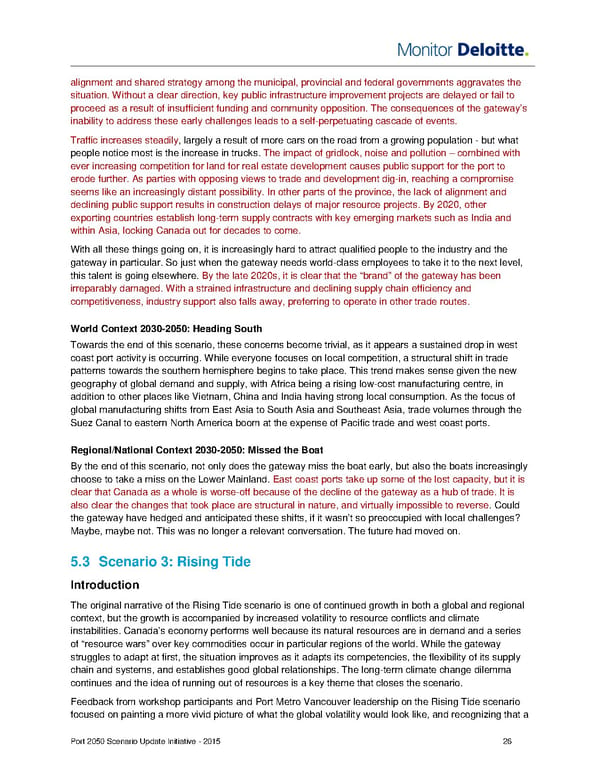alignment and shared strategy among the municipal, provincial and federal governments aggravates the situation. Without a clear direction, key public infrastructure improvement projects are delayed or fail to proceed as a result of insufficient funding and community opposition. The consequences of the gateway’s inability to address these early challenges leads to a self-perpetuating cascade of events. Traffic increases steadily, largely a result of more cars on the road from a growing population - but what people notice most is the increase in trucks. The impact of gridlock, noise and pollution – combined with ever increasing competition for land for real estate development causes public support for the port to erode further. As parties with opposing views to trade and development dig-in, reaching a compromise seems like an increasingly distant possibility. In other parts of the province, the lack of alignment and declining public support results in construction delays of major resource projects. By 2020, other exporting countries establish long-term supply contracts with key emerging markets such as India and within Asia, locking Canada out for decades to come. With all these things going on, it is increasingly hard to attract qualified people to the industry and the gateway in particular. So just when the gateway needs world-class employees to take it to the next level, this talent is going elsewhere. By the late 2020s, it is clear that the “brand” of the gateway has been irreparably damaged. With a strained infrastructure and declining supply chain efficiency and competitiveness, industry support also falls away, preferring to operate in other trade routes. World Context 2030-2050: Heading South Towards the end of this scenario, these concerns become trivial, as it appears a sustained drop in west coast port activity is occurring. While everyone focuses on local competition, a structural shift in trade patterns towards the southern hemisphere begins to take place. This trend makes sense given the new geography of global demand and supply, with Africa being a rising low-cost manufacturing centre, in addition to other places like Vietnam, China and India having strong local consumption. As the focus of global manufacturing shifts from East Asia to South Asia and Southeast Asia, trade volumes through the Suez Canal to eastern North America boom at the expense of Pacific trade and west coast ports. Regional/National Context 2030-2050: Missed the Boat By the end of this scenario, not only does the gateway miss the boat early, but also the boats increasingly choose to take a miss on the Lower Mainland. East coast ports take up some of the lost capacity, but it is clear that Canada as a whole is worse-off because of the decline of the gateway as a hub of trade. It is also clear the changes that took place are structural in nature, and virtually impossible to reverse. Could the gateway have hedged and anticipated these shifts, if it wasn’t so preoccupied with local challenges? Maybe, maybe not. This was no longer a relevant conversation. The future had moved on. 5.3 Scenario 3: Rising Tide Introduction The original narrative of the Rising Tide scenario is one of continued growth in both a global and regional context, but the growth is accompanied by increased volatility to resource conflicts and climate instabilities. Canada’s economy performs well because its natural resources are in demand and a series of “resource wars” over key commodities occur in particular regions of the world. While the gateway struggles to adapt at first, the situation improves as it adapts its competencies, the flexibility of its supply chain and systems, and establishes good global relationships. The long-term climate change dilemma continues and the idea of running out of resources is a key theme that closes the scenario. Feedback from workshop participants and Port Metro Vancouver leadership on the Rising Tide scenario focused on painting a more vivid picture of what the global volatility would look like, and recognizing that a Port 2050 Scenario Update Initiative - 2015 26
 Monitor Deloitte - Final Report Page 27 Page 29
Monitor Deloitte - Final Report Page 27 Page 29